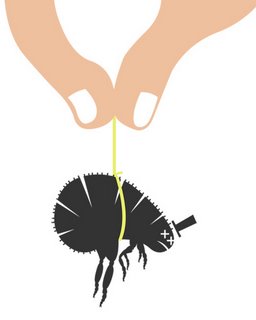skip to main |
skip to sidebar
 The flea circus, which I had always assumed comprised entirely of mechanical (and well synchronised) gymnastic apparatus, is apparently completely real! This may not surprise or worry you, but I've seen The City of Lost Children too many times to not discover more...
The flea circus, which I had always assumed comprised entirely of mechanical (and well synchronised) gymnastic apparatus, is apparently completely real! This may not surprise or worry you, but I've seen The City of Lost Children too many times to not discover more...
So, which flea to use? The connoisseur's choice seems to be the female human flea Pulex irritans, which grows to around 4mm long. To begin with, they must be trained to not jump, which is achieved simply by keeping them in a jar with a lid. Apparently, after repeatedly hitting their head on the lid of the jar, they learn to jump to a lesser height and never regain the ability to jump any higher. Next, a harness (!) of gold thread is tied around their neck (!), which allows you to hilariously tether them to whatever mechanical contraption you have to hand. The 'Chariot Race' seems to be a popular choice [1].
Unfortunately, not all fleas get to spend their lives tethered to chariots for our amusement. At one time fleas were actually glued down to a scene with musical instruments glued to their limbs, with the entire scene heated so that their agonised flailing be made to look like a performance [2].
To be honest, the whole thing freaks me out...
[1] http://www.noonco.com/flea/agitators_streaming.htm
[2] http://www.noonco.com/flea/faq.htm
Image graciously provided by Reilly Stroope
 Flybe use the De Havilland Dash-8 Q400 Turboprop for their internal business flights. Take for example their flight from Manchester to Exeter. In the car, this journey is 240 miles [1], and let's suppose the plane takes a similar-length route.
Flybe use the De Havilland Dash-8 Q400 Turboprop for their internal business flights. Take for example their flight from Manchester to Exeter. In the car, this journey is 240 miles [1], and let's suppose the plane takes a similar-length route.
The plane holds 80 people, and has a maximum range of 1567 miles on a full tank (6526 litres), based on pretty much a full plane [2]. The journey is about 15% of the plane's maximum range, so let's say it uses 15% of a full-tank. This works out to be roughly 1000 litres of aviation fuel, with an almost full load.
If the same 80 people drove 80 cars on the same journey, and each of them were achieving 50 miles/gallon (a very generous assumption!). For the whole journey, they would use a total of 384 gallons, or 1745 litres of fuel. This is in spite of that fact that both aviation fuel and unleaded petrol/gasoline exhibit similar energy densities (~45MJ/kg) [3][4].
[1] AA Route Planner
[2] http://www.q400.com/q400/en/specifications.jsp
[3] http://hypertextbook.com/facts/2003/EvelynGofman.shtml
[4] http://hypertextbook.com/facts/2003/ArthurGolnik.shtml
Image courtesy of preshaa
The adage about the population of the world being able to stand up on the Isle of White is no longer true and furthermore dull. We decided that an entriely new statistic on the world's population would be a good thing.
The world's population has just reached 6.5bn (6,500,000,000) [1]. So, if we assume the average person on the planet weighs 60kg (and that we are mostly water, which weighs 1kg/litre), each human would create 60 litres of knobbly human jam. Nice. So, we've got 360bn litres of 'jam', but where can it go? Lake Windermere, the largest lake in England holds roughly 300bn litres of water [2]. Taking account of the fact that we are not totally comprised of water, an 83.3% liquid yield from everyone on the planet would make it spot on. A decline in tourism may however ensue.
[1] http://en.wikipedia.org/wiki/World_population
[2] http://news.bbc.co.uk/1/hi/england/5343646.stm

